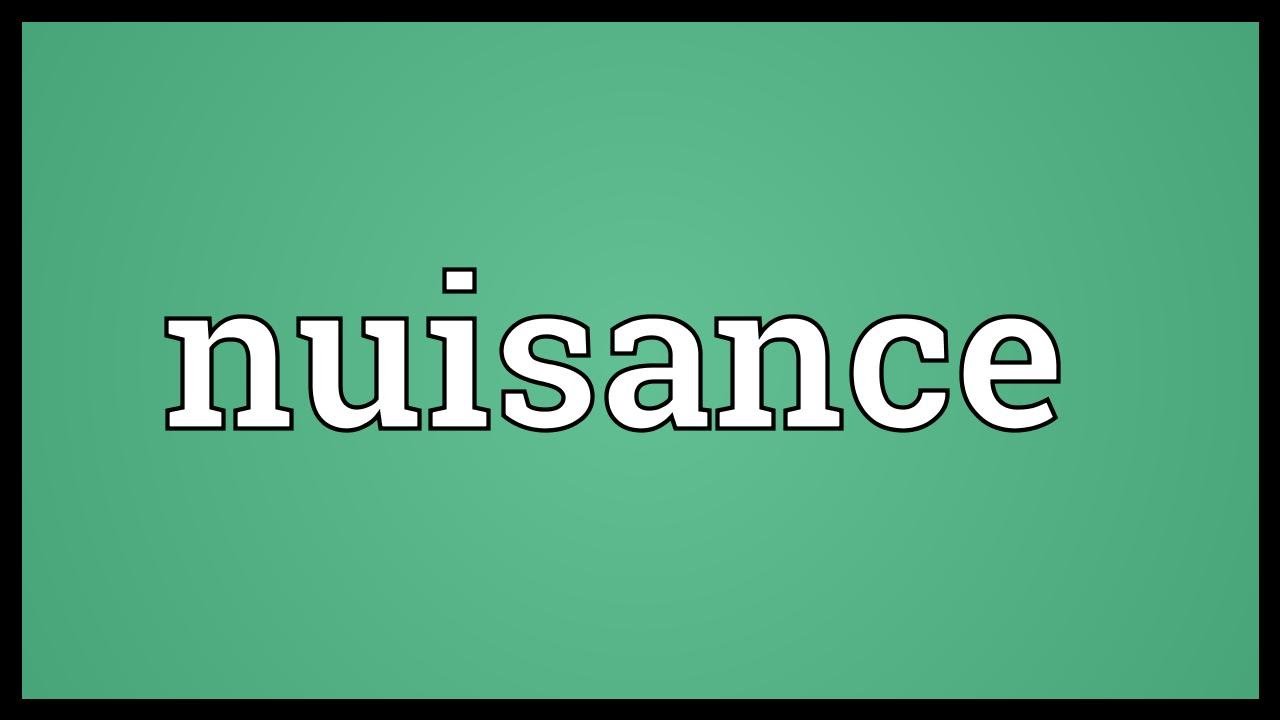Nuisance: Law of Torts : Nuisance: Public and Private
Nuisance is derived from the French word ‘Nuire’ which means to hurt or to annoy. In simple language it means disturbance. According to Prof. Winfield, Nuisance is incapable of exact definition, but it is generally defined as unlawful interference with a person’s use or enjoyment of land or some right over it or in connection with it. Hence it is the inconvenience faced by a man in the enjoyment of his property.
DEFINITION BY VARIOUS THINKERS.
According to STEPHENS “Nuisance is anything done to the hurt or annoyance of the lands, tenements of another, and not amounting to trespass[1]“.
JURIST SALMOND expresses “The wrong of Nuisance consists in causing or allowing without lawful justification the escape of any deleterious thing from his land or from elsewhere into land in possession of the plaintiff, e.g. water, fumes, smoke, gas, noise, heat, vibration, electricity, disease, germs, animals[2]“.
DISTINCTION BETWEEN NUISANCE AND TRESPASS.
- Trespass is the direct interference with the personal use or enjoyment of the land through some tangible object, while Nuisance is the indirect interference in reasonable enjoyment of some legal right.
- Trespass is actionable per se, while Nuisance is actionable on the proof of special damages. They are mutually exclusive of each other.
ESSENTIAL ELEMENT OF NUISANCE.
For making Nuisance actionable under law. The following elements must be satisfied.
- Unreasonable or unlawful interference
An act done with or without intention causing an infringement of the legal right of another is considered as a wrongful act. If the defendant’s action is extra sensitive and the defendant’s sensitivity, which otherwise is reasonable.
- Damage or annoyances
Damage or annoyance must be such that it causes substantial injury in the eyes of the law to make it actionable.
KIND OF NUISANCE.
PUBLIC NUISANCE
A person must have done any act or omission which cause annoyance to the world at large or some considerable portion of society or affect the right which they might enjoy over the property. The act which seriously affects the health, safety or comfort of the general public can be treated as a public nuisance. In India public nuisance comes under the purview of Criminal Acts, the principal reason for placing Nuisance under criminal aspects is that it is committed against the public at large, thereby infringing their legal right. Furthermore any crime under I.P.C. is committed against the state or the public; the similarity puts Nuisance under the domain of criminal law. Public Nuisance can be claimed without proving special damages, under section 91 of Civil procedure code, allow civil action without the proof of special damages. It reads as follow.
“S. 91. (1) In the case of a public nuisance or other wrongful act affecting, or likely to affect, the public, a suit for a declaration and injunction or for such other relief as may be appropriate in the circumstances of the case, maybe instituted[3]“.
A brief of statutes dealing with Public Nuisance as a crime rather than a mere Tort may be given as under-
- Section 3(48) of the General Clauses Act[4], which gives meanings of various legal terms mentions the definition of Public Nuisance to be comprehensively given under the Indian Penal Code.[5]
- Section 268 of the Indian Penal Code defines Public Nuisance as “An act or illegal omission which causes any common injury, danger or annoyance to the people in general who dwell, or occupy the property, in the vicinity, or which must necessarily causeinjury, objection, danger or annoyance to persons who may have occasion to use any public right.”
Soltau v. De Held[6]
The plaintiff lived in a house next to the Roman Catholic Chapel in which the defendant was a priest, and the bell of the chapel rung at all hours of the day and night. The ringing was held to be a public nuisance, and the complainant was found entitled to an injunction.
Leanse v. Egerton[7]
When walking on the highway, the plaintiff was injured on a tuesday night by glass falling from a window in an unoccupied house belonging to the defendant, having broken the window during a storm on the previous Friday night.The court held them liable.
Attorney General v. P.Y.A. Quarries[8]
In this case the Attorney General’s instance, it was held that the vibration of the nuisance form causing personal distress was sufficiently common to lead to a public nuisance and that injunction was adequately issued against the proprietors of the quarry prohibiting them from carrying out their operations.
Ushaben V. Bhagyalaxmi Chitra Mandir[9]
In this case, the plaintiff is against the screening of movie “Jai Santoshi Maa”, claiming that it hurts the religious feeling of the Hindu community, the court rejected the plea and future stated that to Hurt the religious sentiment is not actionable wrong and the plaintiff is free not to watch the movie again.
Halsey V. Esso Petroleum Co. Ltd.[10]
Where the defendant’s factory emitted smokes, oil, fumes and smells and polluted the environment as well as harming the health of the plaintiff because of its own sensitive health issue, the former was held liable to the latter only for smoke, oil and smoke emissions and not for health hazards.
PRIVATE NUISANCE
It is a nuisance in which a person right or enjoyment of his right over the property is ruined by another. It may be with a tangible or intangible object. It gives the affected person a claim of “Right in Personam”. Technically, when a person does an act that affects another person and prevents him from exercising his right over his property. It doesn’t affect any other person other than the plaintiff. A remedy for private Nuisance is a civil action for damages injunction or both. The plaintiff can ask for unliquidated damages considering the seriousness of the injury.
St. Hellen Smelting Co. V. Tipping[11]
Where the fumes from the Defendant’s Factory caused harm to the Plaintiff’s Trees, the court held that the harm to the trees constituted unreasonable damage to the property of the Latter and, therefore, resulted in an action against the former for Nuisance.
Dilaware Ltd. V. Westminister City Council[12]
Where roots of the trees of the defendant created cracks in adjacent house, the plaintiff, i.e. the owner of the property, was entitled by the Right of Tort of Nuisance to recover sufficient damages from the defendant.
Hollywood Silver Fox Farm Ltd v Emmett[13]
A carried on the breeding business of silver foxes on his estate. The vixens are very nervous during the breeding season and are liable if disturbed to either refuse to breed or miscarry or kill their young. B, an adjacent landowner, maliciously caused his son to fire weapons as near as possible to the breeding pens on his land to annoy the A’s vixens.
Dilaware Ltd. v. Westminister City Council[14]
The respondent was the owner of a tree that grew on the highway footpath. Tree roots created cracks in the adjacent house. Once the cracks were found, the transferee of the property’s property was left entitled to recover fair remedial expenditure in relation to the entire harm incurred by the trees’ continued nuisance’.
REMEDIES FOR NUISANCE
If an action of Nuisance is established in the court of law. The following remedies may be provided
- Damages
The court may order the defendant to pay proportionate damages to the victim, depending on the severity of the inconvenience suffered by the aggrieved party. These awards can provide compensation for both monetary and materials.
2. Abatement
Abatement of Nuisance means removing Nuisance by the plaintiff without any legal proceedings. This remedy is usually not favoured by law, but available under certain circumstances This right must be exercised in a fair amount of time and typically allows the defendant to be aware and his actions.and is fair to use the abatement and if his acts go beyond reasonable measures
3. Injunction
An injunction is a judicial order that forbids a person from carrying out or continuing an act that may violate or infringe the legal rights of another person. It can be issued in the form of the temporary order that can be revoked or confirmed for a limited time. If true, a permanent injunction will take the form.
CONCLUSION
The law of Nuisance is almost an uncodified, but it has developed over the year with a plethora of judicial pronouncement. Nuisance as a tort is commonly encountered in society or in men’s daily life. The decision varies from case to case ensuring that neither the aggrieved party goes back uncompensated nor the innocent defendant held liable. The Indian courts had adopted various decision of English court and common law country and also set up a various precedent which ensures fairness, equity in the decision making of the court.
REFERENCE.
- [1] Sir J. F. Stephen, Digest of the Criminal Law, p.120.
- [2] John Salmond Salmond on Torts (16th ed, Sweet & Maxwell, London, 1973) at 52.
- [3] Section 91(1) of IPC.
- [4] General Clauses act, 1897; Av at:[http://www.delhihighcourt.nic.in/library/acts_bills_rules_regulations/General%20Clause%20Act.pdf]
- [5] Indian Penal Code 1860; Av. At:[ http://lawcommissionofindia.nic.in/1-50/report42.pdf]
- [6] (1851) 2 Sim NS 133.
- [7] (1943) 1 KB 323.
- [8] (1957)1 All ER 894.
- [9] AIR 1978 Guj 13.
- [10] (1961) 2 All ER 145.
- [11] (1865) 77 HCL 642.
- [12] (2001) 4 All ER 737 (HL).
- [13] (1936) 2 KB 468.
- [14] (2001) 4 All ER 737 (HL).
Read Also: Object, Constitutional Validity and Salient features of Minimum Wages Act, 1948




![Call for Campus Ambassadors by Our Legal World [2 Months; Virtual]: Apply by June 15](https://www.ourlegalworld.com/wp-content/uploads/2024/06/Logo-New-136x150.png)


